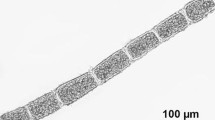Abstract
DESPITE the importance of cyanobacteria in global primary productivity1and of heterotrophic bacteria in the consumption of organic matter in the sea2, the causes of their mortality, particularly the cyanobacteria, are poorly understood. It is usually assumed that mortality is due to protozoan grazing3,4 rather than to viral infection, probably because abundances of phage and host in nature are presumed to be low5. Previously, either very few marine bacteriophages have been found by plaque assays6–9, or viruses have been simply observed10–12or counted13,14 by transmission electron microscopy, with the assumption that 'phage-looking' forms are locally active bacteriophages. Here we report not only high viral abundance in the ocean but also counts of bacteria and cyanobacteria in the final irreversible stage of lytic infection. The latter counts are necessary to evaluate mortality, because the sources, hosts, viability and ages of observed free viruses are unknown; even finding viruses attached to cells does not prove successful infection. Up to 7% of the heterotrophic bacteria and 5% of the cyanobacteria from diverse marine locations contained mature phage; interpretation via culture data indicates that up to 70% of the prokaryotes could be infected. These data demonstrate the existence of a significant new pathway of carbon and nitrogen cycling in marine food webs and have further implications for gene transfer between marine organisms.
Similar content being viewed by others
References
Waterbury, J. B., Watson, S. W., Valois, F. W. & Franks, D. G. in Phyotosynthetic Picoplankton (eds Platt, T. & Li, W. K. W.) 71–120 (Department of Fisheries and Oceans, Ottawa, Canada, 1986).
Azam, F. et al. Mar. Ecol. Prog. Ser. 10, 257–263 (1983).
Fenchel, T. Mar. Ecol. Prog. Ser. Microbiol. 9, 35–42 (1982).
Sherr, E. B. & Sherr, B. F. Nature 325, 710–711 (1987).
Wiggins, B. and Alexander, M. Appl. envir. Microbiol. 49, 19–23 (1985).
Spencer, R. in Symposium on Marine Microbiology (ed. Oppenheimer, C. H.) 350–365 (Charles Thomas, Springfield, Illinois, 1963).
Kriss, A. E. in Microbial Populations of Oceans and Seas (eds Kriss, A. E., Mishustina, I. E., Mitskevich, N. & Zentsova, E.) 230–237 (St Martins's, New York, 1967).
Hidaka, T., Kawaguchi, T. & Shirahama, M. Mem. Fac. Fish. Kagoshima Univ. 28, 47–55 (1979).
Moebus, K. Helgoländerwiss Meeresunters. 36, 375–391 (1983).
Sieburth, J. McN. Sea Microbes, 62 (Oxford University Press, New York, 1979).
Johnson, P. W. & Sieburth, J. McN. J. Phycol. 18, 318–327 (1982).
Frank, H. & Moebus, K. Helgoländerwiss Meeresunters. 41, 385–414 (1987).
Torrella, F. & Morita, R. Y. Appl. envir. Microbiol. 37, 774–778 (1979).
Bergh, Ø., Børsheim, K. Y., Bratbak, G. & Heldal, M. Nature 340, 467–468 (1989).
Kellenberger, E., Sechaud, J. & Ryter, A. Virology 8, 478–490 (1959).
Valentine, A. F. & Chapman, G. B. J. Bact. 92, 1535–1554 (1966).
Smith, L. S. & Krueger, A. P. J. gen. Physiol. 38, 161–168 (1954).
Proctor, L. M., Fuhrman, J. A. & Ledbetter, M. C. Eos 69, 1111–1112 (1988).
Fuhrman, J. A. & McManus, G. B. Science 224, 1257–1260 (1984).
Miller, M. in Principles and Techniques of Electron Microscopy (ed. Hayat, M. A.) 89–128 (Van Nostrand, New York, 1974).
Hobbie, J. E., Daley, R. & Jasper, J. P. Appl. envir. Microbiol. 33, 1225–1228 (1977).
Leach, J. A., Lee, K. W., Benson, R. L. & Martin, E. L. J. Physiol. 16, 307–310 (1980).
Belfort, G., Rotem, Y. & Katznelson, E. Water Res. 10, 279–284 (1976).
Estis, L. F., Haschemeyer, R. H. & Wall, J. S. J. Microscopy 124, 313–316 (1981).
Sherr, B. F., Sherr, E. B. & Fallon, R. D. Appl. envir. Microbiol. 53, 958–965 (1987).
Johnson, P. W. & Sieburth, J. McN. Limnol. Oceanogr. 24, 928–935 (1979).
Author information
Authors and Affiliations
Rights and permissions
About this article
Cite this article
Proctor, L., Fuhrman, J. Viral mortality of marine bacteria and cyanobacteria. Nature 343, 60–62 (1990). https://doi.org/10.1038/343060a0
Received:
Accepted:
Issue Date:
DOI: https://doi.org/10.1038/343060a0
- Springer Nature Limited
This article is cited by
-
Contrasting drivers of abundant phage and prokaryotic communities revealed in diverse coastal ecosystems
ISME Communications (2023)
-
Vitamin B12 is not shared by all marine prototrophic bacteria with their environment
The ISME Journal (2023)
-
Counting dots or counting reads? Complementary approaches to estimate virus-to-microbe ratios
The ISME Journal (2023)
-
Abundant and cosmopolitan lineage of cyanopodoviruses lacking a DNA polymerase gene
The ISME Journal (2023)
-
Modeling the Spread and Control of Viral Infection in Damaged Aquatic System: Emergence of Patterns
Iranian Journal of Science (2023)





